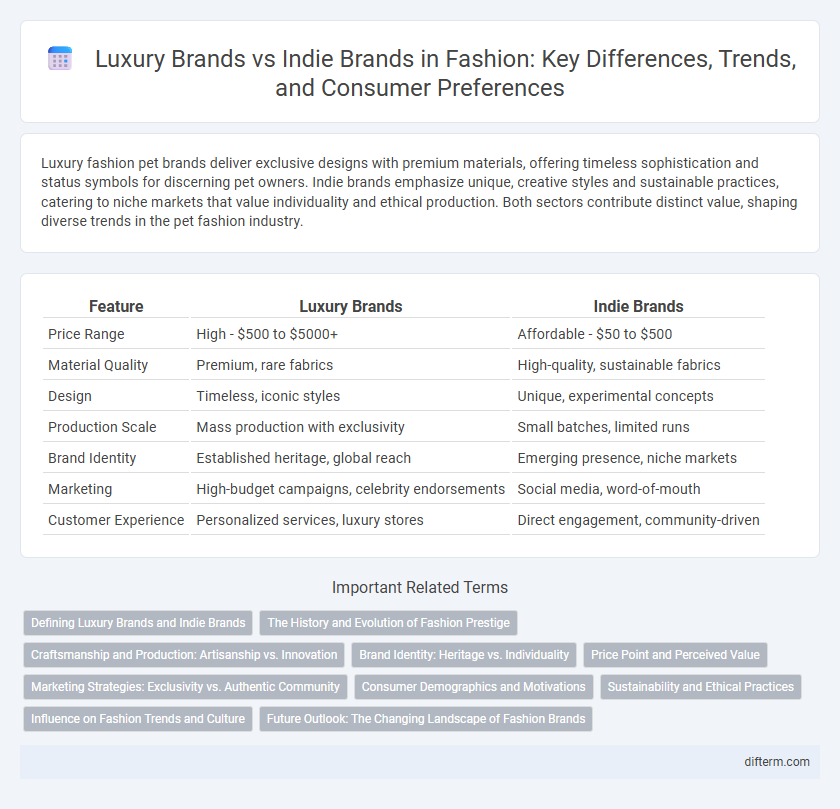Luxury fashion pet brands deliver exclusive designs with premium materials, offering timeless sophistication and status symbols for discerning pet owners. Indie brands emphasize unique, creative styles and sustainable practices, catering to niche markets that value individuality and ethical production. Both sectors contribute distinct value, shaping diverse trends in the pet fashion industry.
Table of Comparison
| Feature | Luxury Brands | Indie Brands |
|---|---|---|
| Price Range | High - $500 to $5000+ | Affordable - $50 to $500 |
| Material Quality | Premium, rare fabrics | High-quality, sustainable fabrics |
| Design | Timeless, iconic styles | Unique, experimental concepts |
| Production Scale | Mass production with exclusivity | Small batches, limited runs |
| Brand Identity | Established heritage, global reach | Emerging presence, niche markets |
| Marketing | High-budget campaigns, celebrity endorsements | Social media, word-of-mouth |
| Customer Experience | Personalized services, luxury stores | Direct engagement, community-driven |
Defining Luxury Brands and Indie Brands
Luxury brands in fashion are characterized by their high-quality materials, exclusive craftsmanship, and strong heritage, often commanding premium prices and catering to a niche market seeking status and timeless elegance. Indie brands emphasize innovative design, sustainable practices, and unique storytelling, appealing to consumers who value authenticity and individuality over mass appeal. The differentiation lies in luxury brands' established prestige and tradition versus indie brands' focus on creativity, transparency, and ethical production.
The History and Evolution of Fashion Prestige
Luxury brands have historically dominated fashion prestige, originating from exclusive ateliers in Paris and Milan during the 19th century, epitomized by names like Chanel and Hermes. Indie brands have evolved by embracing niche markets and innovative designs, challenging traditional luxury dominance through authenticity and sustainability. The fusion of heritage craftsmanship with contemporary values has redefined prestige, balancing timeless elegance and individual expression in modern fashion.
Craftsmanship and Production: Artisanship vs. Innovation
Luxury brands emphasize exceptional craftsmanship rooted in traditional artisanship, often employing skilled handwork and premium materials to create timeless pieces. Indie brands prioritize innovation by integrating cutting-edge techniques, sustainable practices, and experimental designs that challenge conventional aesthetics. Both approaches reflect distinct values in fashion production, balancing heritage and modernity to cater to diverse consumer preferences.
Brand Identity: Heritage vs. Individuality
Luxury brands emphasize heritage through rich histories, established craftsmanship, and iconic logos that convey timeless elegance and status. Indie brands prioritize individuality by showcasing unique design perspectives and personalized storytelling that appeal to niche markets and foster authentic connections. Both approaches shape brand identity, with heritage offering trust and legacy, while individuality drives innovation and distinctiveness.
Price Point and Perceived Value
Luxury brands command premium price points driven by craftsmanship, heritage, and exclusive materials, creating a high perceived value among affluent consumers. Indie brands, often priced more affordably, emphasize unique designs and ethical production, appealing to niche markets seeking authenticity and individuality. The perceived value of luxury brands is linked to status and prestige, while indie brands cultivate loyalty through personal connection and storytelling.
Marketing Strategies: Exclusivity vs. Authentic Community
Luxury brands leverage scarcity marketing and limited-edition releases to cultivate an aura of exclusivity that attracts high-net-worth consumers seeking status and prestige. Indie brands emphasize authentic community engagement through storytelling, social media interaction, and personalized experiences to build loyal customer bases driven by shared values and unique identity. Both strategies capitalize on emotional connections but target distinct consumer motivations: luxury brands prioritize aspirational status, while indie brands focus on genuine belonging and individuality.
Consumer Demographics and Motivations
Luxury brands primarily attract affluent consumers aged 30-55 who seek exclusivity, status, and high-quality craftsmanship, often valuing heritage and brand prestige. Indie brands appeal to younger demographics, typically Millennials and Gen Z, who prioritize sustainability, uniqueness, and ethical production in their fashion choices. The motivation for indie brand consumers centers on individuality and social responsibility, contrasting with luxury buyers driven by luxury experience and brand legacy.
Sustainability and Ethical Practices
Luxury brands often implement comprehensive sustainability initiatives, investing in eco-friendly materials and transparent supply chains to meet growing consumer demand for ethical practices. Indie brands, while smaller in scale, typically prioritize artisanal craftsmanship and local sourcing, fostering sustainable production with minimal environmental impact. Both sectors contribute uniquely to the fashion industry's shift toward sustainability, with luxury brands leveraging resources for large-scale changes and indie brands driving innovation through ethical authenticity.
Influence on Fashion Trends and Culture
Luxury brands wield significant influence on fashion trends and culture by setting high standards in design, craftsmanship, and exclusivity, often dictating seasonal motifs adopted globally. Indie brands, meanwhile, drive innovation through grassroots creativity and cultural authenticity, reshaping niche markets and inspiring mainstream designers with fresh perspectives. Both sectors collaboratively push fashion evolution, balancing heritage luxury appeal with avant-garde experimentation.
Future Outlook: The Changing Landscape of Fashion Brands
Luxury brands are increasingly integrating sustainability and digital innovation to maintain exclusivity while appealing to conscious consumers, influencing market dynamics significantly. Indie brands capitalize on agility and unique storytelling, leveraging social media platforms to gain rapid visibility and cultivate niche audiences. The future landscape of fashion will be shaped by the interplay between heritage-rich luxury houses adopting technology and purpose-driven indie labels driving personalized consumer experiences.
luxury brands vs indie brands Infographic

 difterm.com
difterm.com